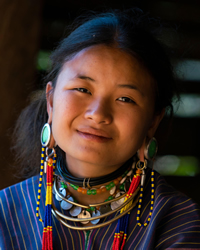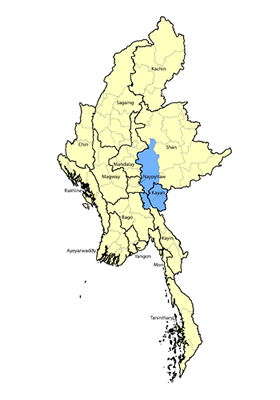The self-name of this tribe is Kayaw, and despite their similar names, they are distinct from the Kayah and Kawyaw tribes who also live in eastern Myanmar. For generations, other ethnicities have called them “Bre” or “Brek,” but the Kayaw people consider these labels pejorative and insist on being called by their correct name. Most sources suggest there are three main divisions of Kayaw people, with women from each group having a mode of dress different from the other groups. First appearing in the 1911 census of Burma when they numbered 6,911 people, the Kayaw population fell in the following two decades to 6,695 in 1931. The decrease could be attributable to a smallpox epidemic that swept through the area in the 1920s.
Location: More than 20,000 people belonging to the Kayaw tribe inhabit 30 villages in western areas of Kayah State, concentrated in Loikaw, Demoso, Hpruso, Bawlakhe and Hpasawng townships. Others spill across the border into northeast Kayin State, where they live in and around Yado village, while still others are found further north in southern Shan State. The Kayaw territory is one of steep forested mountains. A visitor in the 1920s remarked: “It is an emphatic jumble of hills, very high and steep, with exceedingly narrow valleys in between. The natural beauty of the area obscures the fact that a savage civil war has been waged in the Kayaw homeland for more than half a century.
Language: Kayaw is a Central Karenic language within the Tibeto-Burman family. Containing five dialects, it is reportedly related to Bwe Karen, although “some Kayaw who speak with the Bwe Karen may use S'gaw Karen or Burmese to communicate. Kayaw and Bwe are variant names of a dialect continuum extending from southwest Kayah State to northeast Kayin State.”
The Kayaw are a shy tribe who dwell in remote forests, and until recently they were rarely seen. One researcher noted, “They prefer to remain deep in the hills, and this cautious behavior is thought to stem from a time in their history when slave-raiding by outside peoples was commonplace.”
An interesting custom observed by the Kayaw is the ritual washing, every morning and evening, of their babies for one year after birth. The Kayaw "consider this to be enough cleansing for a lifetime and do not encourage their children to wash after their first year." It is the mother's responsibility to name a baby after it is born. She calls on the village shaman to throw his chicken bones and divine whether the child should be named after a relative.
For centuries the Kayaw practiced spirit worship, with shamans acting as the mediators between people and demons. The religious environment began to change when the Gospel was introduced and the first nine Kayaw churches were planted in 1865. It was said, “Hundreds of villages were yet groping in heathen darkness. But year by year the Gospel extended its peaceful conquests, until this highest mountain barrier was reached.”
Later, in 1882, a group of missionaries were terrified when a large band of armed Kayaw men, beating drums, approached them. The chief, a giant of a man named Howee, had not come to attack the Christians, but to request that Bible teachers be sent to lead them into the truth! He said, “If missionaries visit my people, they will turn to the worship of the living God.” The Kayaw church continued to grow, and by the 1931 census, 2,974 (44.4%) of Kayaw declared that they were Christians. Today, nearly nine out of ten Kayaw families believe in Jesus Christ.
Scripture Prayers for the Kayaw in Myanmar (Burma).
| Profile Source: Asia Harvest Copyrighted © Used with permission |











